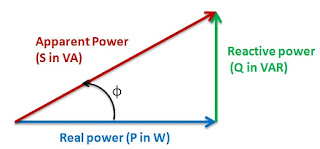power factor correction
What is Power Factor Correction?
POWER FACTOR is the ratio between the useful (true) power (kW) to the total (apparent) power (kVA) consumed by an item of a.c. electrical equipment or a complete electrical installation. It is a measure of how efficiently electrical power is converted into useful work output. The ideal power factor is unity, or one. Anything less than one means that extra power is required to achieve the actual task at hand.
A poor power factor is usually the result of a significant phase difference between the voltage and current at the load terminals, or it can be due to a high harmonic content or a distorted current waveform. A poor power factor is generally the result of an inductive load such as an induction motor, a power transformer, a ballast in a luminaire, a welding set or an induction furnace. A distorted current waveform can be the result of a rectifier, an inverter, a variable speed drive, a switched mode power supply, discharge lighting or other electronic loads.
Why improving Power Factor is important
The Power Factor Correction of electrical loads is a problem common to all industrial and commercial users. Every user which utilizes electrical power to obtain work in various forms continuously asks the mains to supply a certain quantity of active power together with reactive power.
The most common of these on modern systems is the inductive load. Typical examples includes transformer, fluorescent lighting, AC induction motors, Arc/induction, furnaces etc. which draw not, only active power (KW) from the supply, but also inductive reactive power (KVAr). Common characteristics of these inductive loads is that they utilize a winding to produce an electromagnetic field which allows the motor or transformer to function and requires certain amount of electrical power in order to maintain the field. Therefore Active Power (KW) actually performs the work whereas Reactive Power (KVAr) sustains the electro-magnetic field.
his reactive power though is necessary for the equipment to operate correctly but could be interpreted as an undesirable burden on the power supply /Distribution companies. They in turn offer benefits or incentive to consumers to maintain higher power factor near to unity. Most industrial and commercial users are billed in KVAH units therefore higher the power factor lower the KVAH units and KVA demand thereby bringing in direct savings to consumers maintaining higher power factor. Some distribution companies offer discount on KWH billing depending on power factor values. Both way round customer benefits.
Why is it important to control Power Factor using right method?
Many consumers are not aware that Power Factor Correction system if not designed as per load characteristics, can itself result and become a cause for major operational problem in the network. Some of the issues can be :
- Enhanced harmonic distortion.
- Increased losses due to over or under compensation because of mismatch in load variation and response time of Power Factor Correction System.
- Increased switching transients due to more no. of steps switched through Contactors.
- Operational problems in capacitor bank and other network loads due to harmonic resonance.
- Lot of power quality issues in network becomes visible after installation of inadequate PFC System
The above issues may not directly suggest that PF system is responsible but the fact of the matter is that wrongly designed Power Factor Correction system is one of the major cause of operational problems in electrical network.
With experience of last more than 20 years and with installation base of more than 20000 systems all over India and abroad offer their expertise in designing, supplying and installation of high quality Intelligent Power Factor Correction and Harmonic Filtration systems. These systems are designed on the basis of Power Quality Studies and analysis using advanced simulation tools. Further information is also collected from customer or project consultant. Some of these are :
With experience of last more than 20 years and with installation base of more than 20000 systems all over India and abroad offer their expertise in designing, supplying and installation of high quality Intelligent Power Factor Correction and Harmonic Filtration systems. These systems are designed on the basis of Power Quality Studies and analysis using advanced simulation tools. Further information is also collected from customer or project consultant. Some of these are :
- Characteristics and switching time / variation frequency of major loads in the network along with the Rating of Main Transformer and major load feeders where compensation is possible.
- Identifying balanced and unbalanced load condition in network.
- Type and amplitude of harmonic distortion with individual harmonic content.
With above what we achieve for customer is a perfect and most optimized Power Factor Control. This results in enhancing power quality of network thus bringing savings to customer along with minimizing lot of operational problems.


No comments:
Post a Comment